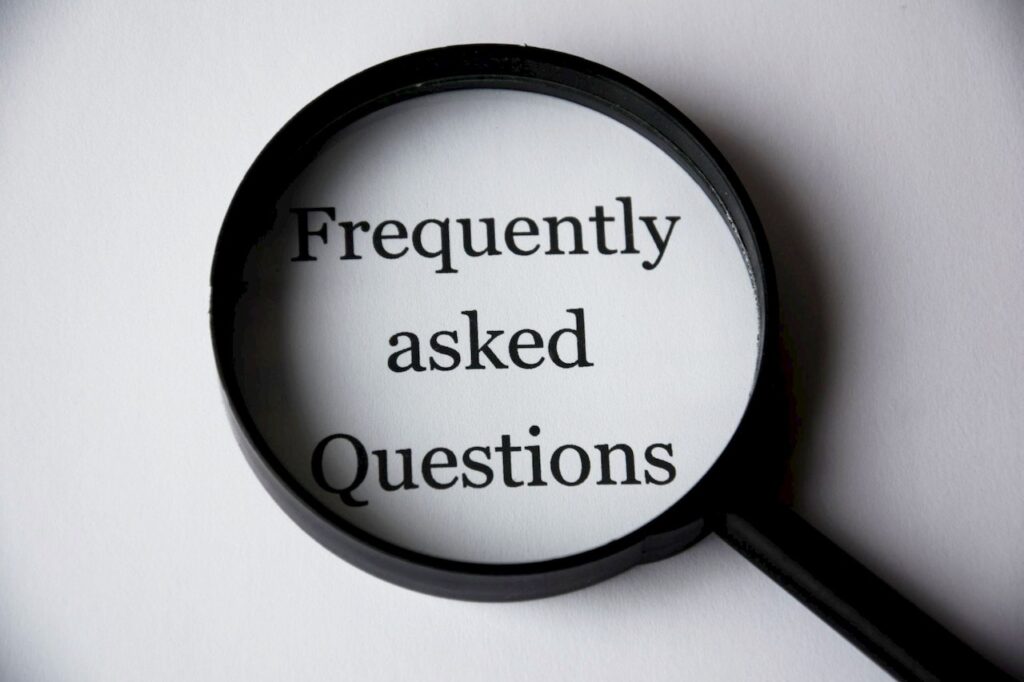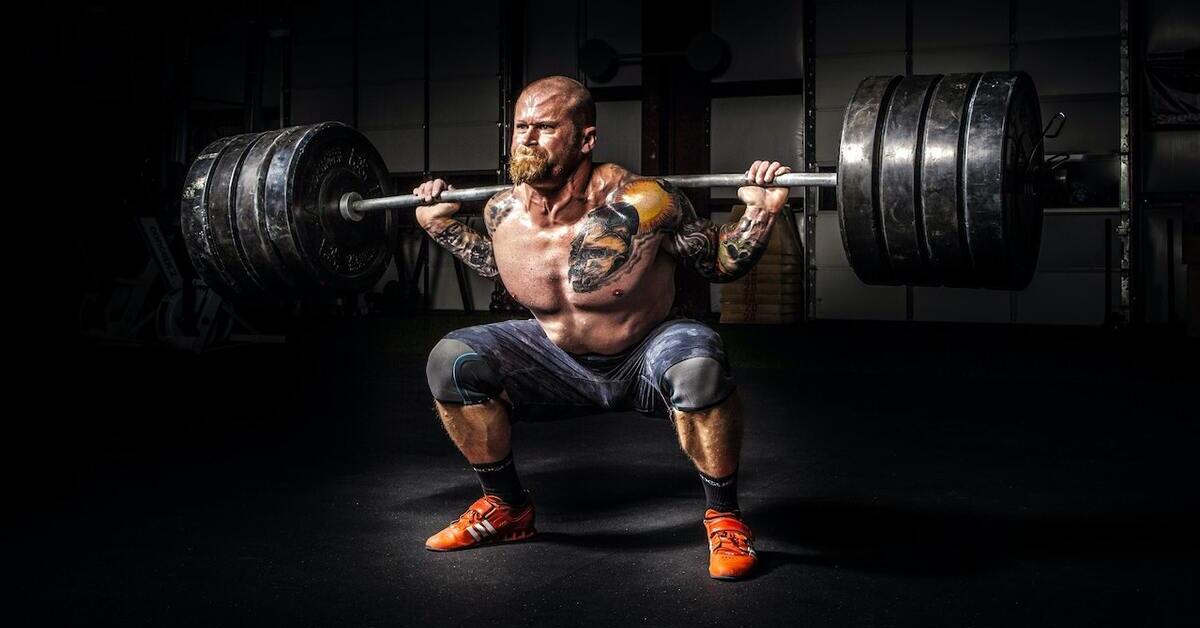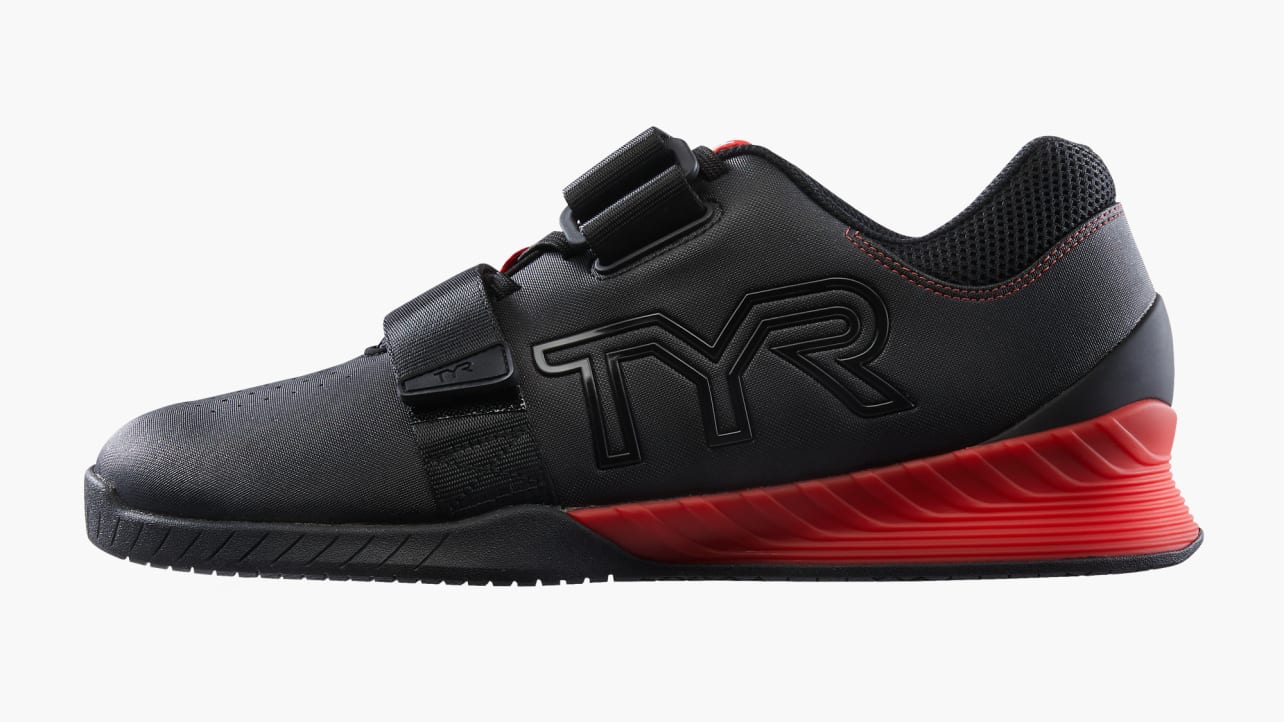Given how popular squat shoes are, even if you’re new to lifting weights, you’ve probably seen or heard about them. Many lifters wear them, especially those that compete in weightlifting. They’re specialized strength training shoes and they can be expensive.
Are squat shoes worth it? That depends on your reasons for wanting to wear them. If you’re experiencing any of the following issues while performing squats, squat shoes might help:
- Your heels come off the floor
- You can’t squat using a full range of motion
- Your lower back rounds at the bottom (“butt wink”)
Although wearing squat shoes might resolve these issues, they shouldn’t be thought of as a magical fix. Nor are they a requirement for strength training. However, if you’re serious about training – they might be right for you.
In this article, we explain squat shoes’ characteristics, benefits, and drawbacks. We’ve also included recommendations for squat shoes, should you decide to buy a pair. Continue reading to learn more about squat shoes and whether or not they’re a good investment for you.
What Are Squat Shoes?

Squat shoes, also known as weightlifting shoes, are designed to help lifters perform barbell exercises that include a bottom squat position, such as the back squat or snatch. They differ from other types of shoes because they have a flat, heavy base and raised heel. Squat shoes are designed solely for lifting weights and shouldn’t be used for other activities.
Squat shoes’ heels can range from 0.6” to 1”. They reduce the amount of ankle mobility needed to perform a full-depth squat and help you maintain an upright torso, which is necessary when performing the snatch and clean and jerk.
The midsoles of squat shoes are thin and hard, or non-compressible, which allows lifters to maintain their stability when performing barbell exercises. Their outsoles are made of hard, anti-slip material, such as rubber. This is to provide adequate traction for lifting weights, which is important for safety and using proper lifting mechanics.
Another key component of squat shoes is their metatarsal straps, which help them fit more snugly. Depending on their brand and model, squat shoes will include one or two metatarsal straps.
Benefits of Squat Shoes

The characteristics of squat shoes, such as their elevated heels and non-compressible soles, can help improve your lifting mechanics for certain exercises. In this section, we’ll explain the benefits of using squat shoes.
Reduce Ankle Mobility Demands
Ankle mobility refers to a person’s ability to perform ankle dorsiflexion, which is flexing their feet towards their shins. Lifters with poor ankle mobility usually have trouble squatting and performing exercises that include a squat position. Two tell-tale signs of having poor ankle mobility are if you have trouble squatting to full depth and if your heels come off the ground at the bottom of the squat.
Squat shoes reduce the ankle mobility demands of the squat, allowing lifters with limited ankle mobility to squat to full depth while keeping their heels on the ground. For some lifters, performing full-depth squats is extremely difficult (or impossible) without squat shoes.
Better Stability
In weightlifting, stability refers to a lifter’s ability to keep their center of mass over their midfoot, which is necessary for maintaining balance. When lifting weights, having a solid base is crucial for maintaining your balance. Having a solid base is sometimes referred to as “having a connection with the ground”. Balance is important because it affects your lifting mechanics.
Wearing shoes with highly-cushioned, compressible midsoles, such as running shoes, isn’t ideal for lifting weights. Compressible midsoles allow your feet to sink into them, making you unstable. The midsoles of squat shoes are non-compressible, making them ideal for lifting weights. They’re designed to provide stability, helping you maintain your balance when lifting.
Better Traction
A shoe’s outsole, or bottom, is the part of the shoe that provides traction, which is what prevents your feet from sliding. When lifting weights, it’s important to wear shoes that provide good traction. Shoes with good traction help prevent your feet from sliding during exercises, which helps you maintain good form and reduces your risk of injury.
The outsoles of squat shoes are designed to provide adequate traction for weightlifting, allowing lifters to squat and perform other exercises without their feet sliding.
Drawbacks of Squat Shoes

While squat shoes can be extremely helpful, they also have drawbacks, which include not being ideal for some exercises, being used as a substitute for mobility work, and being expensive.
Not Ideal for Some Exercises
Wearing squat shoes is advantageous when performing some exercises, but disadvantageous when performing others. When performing an exercise that doesn’t include a squat position, squat shoes might negatively affect the mechanics of the exercise.
An exercise that squat shoes aren’t ideal for is the deadlift. Squat shoes’ heels increase the deadlift’s range of motion, making the exercise more difficult. They also shift your body forward, placing more of the load on your quads. If your goal is to deadlift as much weight as possible, you shouldn’t deadlift in squat shoes.
While you can wear squat shoes for machine exercises, such as the leg press, they’re not necessary, and doing so places extra wear on them.
Some Lifters Use Them as a Substitute for Mobility Work
Another drawback of wearing squat shoes is becoming too reliant on them. While squat shoes can help lifters with poor ankle mobility, they shouldn’t be used like a crutch. This same concept applies to supportive gear, such as knee sleeves and lifting belts.
The point of squat shoes is to enhance your lifting mechanics for the squat and similar exercises, but if you have mobility issues that prevent you from squatting without heeled shoes, you should work on your mobility.
They Can Be Expensive
One thing that might turn some lifters away from squat shoes is how expensive they are. They typically cost between $90 to $220, with some costing over $300. Their cost is mostly affected by their quality. Most squat shoes are made of high-quality, durable materials, which is necessary due to the nature of Olympic weightlifting.
The good news is that while squat shoes can be expensive, they’re designed to last a long time, so you won’t have to replace them as often as other types of shoes.
When to Use Squat Shoes

We’ve explained the advantages and disadvantages of wearing squat shoes, so now, we’ll help you determine whether or not they’re a good investment for you. In this section, we’ll explain the conditions that justify using squat shoes. If any of the conditions below apply to you, you should consider purchasing a pair.
You Have Poor Ankle Mobility
Having poor ankle mobility is one of the most common issues for lifters who squat. As mentioned earlier, not being able to keep your heels on the floor at the bottom of the squat might mean you have poor ankle mobility. If your heels come off the floor when you squat, you might want to invest in a pair of squat shoes.
The elevated heels of squat shoes force your knees forward at the bottom of the squat, increasing the angle of your shins and decreasing the amount of ankle dorsiflexion you need to squat to full depth. This will allow you to keep your heels on the ground when squatting down.
You Want More Quad Involvement
If you’re able to squat properly in flat shoes but want a more quad-dominant squat, you should consider squatting in squat shoes. By forcing your hips and knees forward, squat shoes place more of the load onto your quadriceps.
Usually, deadlifting in squat shoes isn’t recommended because of how elevated heels affect the deadlift’s mechanics, but if your goal is to use more muscle mass during the deadlift, wearing them might be appropriate. Mark Rippetoe, the founder of Starting Strength, suggests deadlifting in squat shoes in his strength training programs.
You Compete in Weightlifting
If you’re going to be competing in weightlifting, squat shoes are a necessity. You’d be hard-pressed to find a serious weightlifter that doesn’t lift in squat shoes. This is because squat shoes help you remain upright and reach proper depth when performing the Olympic lifts.
The Olympic lifts are complex exercises. Having stability and a good base is necessary to properly perform the Olympic lifts, which is why it’s important to wear the proper footwear.
Alternatives to Squat Shoes

Squat shoes aren’t your only option for footwear when squatting. Cross-training shoes and flat lifting shoes can also be worn or you can squat barefoot.
Cross Trainers
Cross trainers, or CrossFit shoes, are strength training shoes that have a slightly raised heel. Their purpose, as their name suggests, is to be used for cross training, or performing multiple types of exercises.
Cross trainers’ slightly raised heels are enough for many lifters to be able to squat properly, so they can be a good alternative to squat shoes. Their heels reduce the amount of ankle mobility necessary for squatting, but not as much as squat shoes’ heels.
Cross trainers are very popular in the CrossFit community. Although they’re similar to weightlifting and powerlifting shoes, they’re rarely worn in weightlifting and powerlifting competitions.
Flat Lifting Shoes
If you want to utilize your hips more when squatting, you should wear flat lifting shoes. Since they don’t have elevated heels, your knees won’t travel forward at the bottom of the squat, reducing some of the tension placed on your quadriceps. This allows more tension to be placed on your hips.
One good thing about choosing to squat in flat shoes is that it can save you money. You can use them for most weight training exercises, so you won’t need to buy an additional pair of strength training shoes for other exercises. The exception is Olympic weightlifting exercises, which we recommend wearing squat shoes for.
Lifting Barefoot
Another option is to lift barefoot, although we don’t recommend doing this. If you want your feet to be as close to the floor as possible when lifting, nothing will get them closer than lifting barefoot. The drawbacks of barefoot lifting are that it can be unsanitary and dangerous. An alternative to lifting barefoot is to wear minimalist shoes or deadlift slippers.
Recommended Squat Shoes
In addition to explaining the advantages and disadvantages of using squat shoes, we’ve explained how to determine if they’ll be beneficial to you. If you decide to invest in squat shoes, it’s important that you choose a good pair. Below are 5 squat shoes that we recommend.
Adidas Powerlift 4
The Adidas Powerlift 4 is affordable and has a moderate heel height (15mm), making it a great squat shoe for beginners. Although the name implies that it’s made for powerlifting, it’s actually an Olympic weightlifting shoe. The Powerlift 4’s upper is made of high-quality canvas, enhancing its durability. The shoe has a single strap, which is enough to make it fit snugly. The outsoles are made of rubber and provide good traction for weightlifting.
The Powerlift 4’s price, which is lower than similar shoes, can be partially attributed to its heel being made of EVA (ethylene-vinyl acetate) foam. While dense EVA foam is sturdy, it’s more compressible than other materials, such as wood.
Reebok Lifter PR 2
The Reebok Lifter PR 2 is another good option for beginners. It has a lower heel height (15mm) than most squat shoes and is priced affordably. The PR 2’s anti-slip rubber soles provide traction for performing movements like squats and other barbell exercises. Similar to the Adidas Powerlift 4, the Reebok lifter PR 2 features a single foot strap.
Also similar to the Powerlift 4, the PR 2’s soles are made o f high-density EVA Foam, which isn’t the best material for the soles of squat shoes.
Nike Romaleos 4
Earlier squat shoes had bases that were made of wood, which made them expensive. To make their shoes more affordable, companies switched to a synthetic material called TPU (thermoplastic polyurethane). A popular squat shoe that utilizes TPU for its soles is the Nike Romaleos 4. It provides a solid base for performing squats and Olympic-style lifts. While the Romaleos 4’s heels (0.75”) are taller than the PR 2’s, they’re still shorter than some squat shoes.
Many lifters have reported that while the Rom 4 is sturdy and worth the investment, its straps need improvement. Its straps are known for not being as durable as the rest of the shoe. Also, the Romaleos 4 is pricey.
Reebok Legacy Lifter 3
The Legacy Lifter 3 is Reebok’s answer to the Nike Romaleos 4. Its features are similar to the Rom 4’s, but its heel height and toe box are slightly different. The Lifter 3’s heels are 22mm, making them taller than the Romaleos 4’s, and the Lifter 3’s toe box is wider than the Romaleos 4’s, which is great for lifters with wide feet. The Lifter 3 has one single wide strap versus previous models that had two.
The Reebok Legacy Lifter 3’s pump is mainly just for show. Pumping the shoe up doesn’t make it fit more snugly. Also, similar to the Romaleos 4, the Lifter 3 has a high price tag.
TYR L-1
The TYR L-1 might be a great option for lifters with wide feet. One of its major selling points is having a wide toe box to mimic squatting barefoot. The L-1’s heel height (21mm) is slightly less than the Legacy Lifter 3’s, and its base is made of TPU, which is common for squat shoes. It has two foot straps, which can help enhance stability.
While many lifters praise the TYR L-1’s wide toe box, some lifters have stated that while they do like how comfortable the TYR L-1 is, its wide toe box doesn’t make a significant difference. The L-1 is somewhat pricey, so it might not be worth investing in if you don’t have wide feet.
Frequently Asked Questions

Are Squat Shoes Necessary?
Squat shoes aren’t necessary, but they can help improve your lifting mechanics when squatting or performing Olympic weightlifting exercises. If you plan on training for Olympic weightlifting or have trouble squatting to full depth, we recommend investing in a pair of squat shoes.
Do Squat Shoes Make a Difference?
Yes, squat shoes make a difference. Their elevated heels reduce the amount of ankle dorsiflexion necessary to perform a full squat. Their midsoles are non-compressible, providing a solid base to push off of and enhancing stability.
Are Squat Shoes Good for Deadlifts?
We don’t recommend deadlifting in squat shoes. Their heels will shift your body forward at the bottom of the lift, altering your lifting mechanics. Also, elevated heels increase the deadlift’s range of motion, making the exercise more difficult to perform.
The Bottom Line: Are Squat Shoes Worth It?
All the information in this article is meant to inform you about squat shoes and help you decide whether or not they’re a good investment. Are squat shoes necessary? No, but they make things easier. If you have poor ankle mobility and don’t want to use squat shoes, you can try doing exercises and stretches to improve your ankle mobility.
Are squat shoes worth it? Yes. Although squat shoes aren’t necessary, they can make a difference. Even though they’re somewhat costly compared to other shoes, they’re designed to be durable, and if they’re taken care of, they can last many years. If you’re serious about training, squat shoes are worth the investment.
Jay is not just a writer; he’s a seasoned strength enthusiast with two decades of dedicated training under his belt. Whether he’s crafting engaging articles, reviewing cutting-edge equipment, or sharing his personal fitness anecdotes, Jay’s writing resonates with a diverse audience, from seasoned gym enthusiasts to beginners eager to embark on their own transformative fitness paths.





